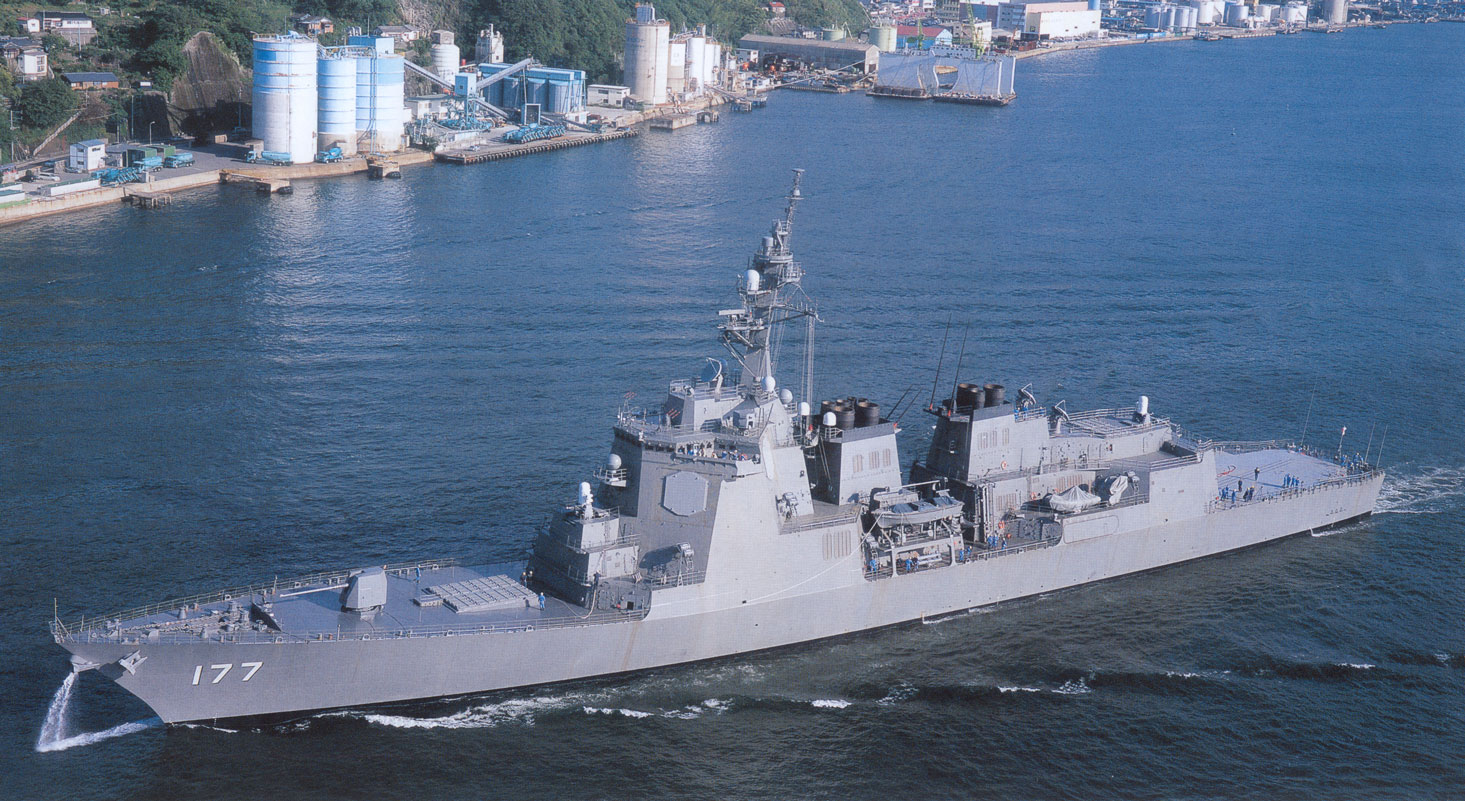The Greatest Eyes in the Oce....OUCH!!!!
Japan is proud of her five Aegis destroyers, and rightly so. Based on the U.S. Arleigh Burke class, they are among the most sophisticated and capable military (er, sorry...non-military) vessels in the world. With their highly advanced detection and scanning equipment they can locate, identify, and track multiple targets on or under the surface of the ocean or in the air as well as guide weapons to them.
However, as it turns out, they may not be so good at spotting small vessels under their very noses.

JDS Atago. This image as well as many other excellent views of the ship may be found on this Chosun website. Note that it is a Korean-language site.
JDS Atago is the first vessel and namesake of the brand-new Atago class. An improvement over the four-vessel Kongo class, she is currently the only one of her kind and will remain so until her sister ship, the Ashigara, enters service next month. She is less than a year old and, though commissioned, is still very much in the process of being broken in. Last November she headed off to Hawaii for a few months of live-fire exercises involving her SM-2 missile launchers. The exercises had been completed, and she was returning to her home port in Japan.
Apparently, while powering toward Tokyo Bay late at night, she failed to notice the Seitoku Maru, a small fishing boat. The Aegis destroyer came out of it with only a few scars. The fishing boat, however, was sheared in half, and its two crew members are still missing.
There are many international laws in place, most of them ancient, to help ships at sea avoid colliding. Japan has also added a few additional rules to account for local conditions. Basically, ships approaching each other at night are supposed to take note of the color and position of the running lights of the other vessel and adjust course so that they always pass on the right. One exception, however, is operating fishing vessels; since adjusting course could affect their catch, they are given automatic right of way. Apparently the officer on bridge duty on the Atago failed to realize that and just assumed any smaller craft in the area would get out of his path. At the same time, however, it has also been suggested, though not officially admitted, that the fishing boat may not have had its lights on. After all, other fishing vessels in the area apparently radioed in that they could see a military vessel (i.e. the Atago) approaching, but no one knew the position of the Seitoku Maru until after the collision. At the very least, the officer of the watch on Atago insists they never saw the smaller vessel until they were virtually on top of it, and by then it was too late.
Even more mind-boggling, apparently the Atago didn't report the accident to the Japanese Coast Guard (JCG) until some fifteen minutes had passed. The Defense Ministry wasn't notified until almost two hours later. Needless to say, the captain has a lot of explaining to do.
I guess the bottom line is that, no matter how sophisticated the equipment at one's disposal, it's still no better than the judgment of the person or persons using it. Human fallibility is still human fallibility. I only hope Al Qaeda isn't taking notes...
However, as it turns out, they may not be so good at spotting small vessels under their very noses.

JDS Atago. This image as well as many other excellent views of the ship may be found on this Chosun website. Note that it is a Korean-language site.
JDS Atago is the first vessel and namesake of the brand-new Atago class. An improvement over the four-vessel Kongo class, she is currently the only one of her kind and will remain so until her sister ship, the Ashigara, enters service next month. She is less than a year old and, though commissioned, is still very much in the process of being broken in. Last November she headed off to Hawaii for a few months of live-fire exercises involving her SM-2 missile launchers. The exercises had been completed, and she was returning to her home port in Japan.
Apparently, while powering toward Tokyo Bay late at night, she failed to notice the Seitoku Maru, a small fishing boat. The Aegis destroyer came out of it with only a few scars. The fishing boat, however, was sheared in half, and its two crew members are still missing.
There are many international laws in place, most of them ancient, to help ships at sea avoid colliding. Japan has also added a few additional rules to account for local conditions. Basically, ships approaching each other at night are supposed to take note of the color and position of the running lights of the other vessel and adjust course so that they always pass on the right. One exception, however, is operating fishing vessels; since adjusting course could affect their catch, they are given automatic right of way. Apparently the officer on bridge duty on the Atago failed to realize that and just assumed any smaller craft in the area would get out of his path. At the same time, however, it has also been suggested, though not officially admitted, that the fishing boat may not have had its lights on. After all, other fishing vessels in the area apparently radioed in that they could see a military vessel (i.e. the Atago) approaching, but no one knew the position of the Seitoku Maru until after the collision. At the very least, the officer of the watch on Atago insists they never saw the smaller vessel until they were virtually on top of it, and by then it was too late.
Even more mind-boggling, apparently the Atago didn't report the accident to the Japanese Coast Guard (JCG) until some fifteen minutes had passed. The Defense Ministry wasn't notified until almost two hours later. Needless to say, the captain has a lot of explaining to do.
I guess the bottom line is that, no matter how sophisticated the equipment at one's disposal, it's still no better than the judgment of the person or persons using it. Human fallibility is still human fallibility. I only hope Al Qaeda isn't taking notes...



3 Comments:
Haven't got enough time to stop and read this now, but I was reading earlier about the possibility of the Navy shooting down the US 361 satellite, using an Aegis destroyer, 20 of which have been ordered by Japan.
By Olivia, at 8:24 AM
Olivia, at 8:24 AM
The navigational radar on even high tech military vessels is similar to any other ship. It is the sonar and longer range radars that would pick up ships at a distance or aircraft and missiles that are the really leading edge stuff.
10,000 ton destroyer meets 7 ton fishing boat. Bound to have a sad ending.
A lesson for fishermen is to 1) make sure your running lights are on, and 2) keep a radar reflector (they're cheap) at the top of a mast so other ships will see you on the screen. Though latest reports indicate that the destroyer did see the light of the boat and failed to take timely action to avoid a collision. Someone does indeed have a lot of 'splaining to do.
This incident reminds me of the one in the book "Snow Falling On Cedars". Loved that book and the movie.
By Pandabonium, at 7:29 PM
Pandabonium, at 7:29 PM
I dunno, though. I watched an animated simulation on the news showing the movements of all the craft in the vicinity leading up to the accident, and something seems a bit fishy (no pun intended). It looks like three or four of the fishing boats were intentionally approaching the destroyer and criss-crossing its path. Was this a case of politically-motivated harassment, i.e. playing "chicken", that went awry?
Considering the two fishermen on the boat have yet to turn up in any form, I also can't help having a tiny but nagging suspicion in the back of my mind that Al-Qaeda might have been testing a new terror tactic to use against American ships.
By The Moody Minstrel, at 7:36 PM
The Moody Minstrel, at 7:36 PM
Post a Comment
<< Home